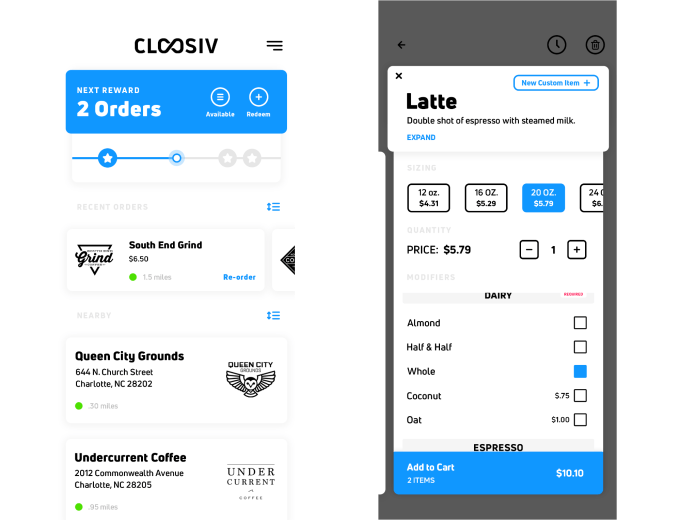Music
Trailers
DailyVideos
India
Pakistan
Afghanistan
Bangladesh
Srilanka
Nepal
Thailand
StockMarket
Business
Technology
Startup
Trending Videos
Coupons
Football
Search
Download App in Playstore
Download App
Best Collections
Technology
A few months back we took a look at Cloosiv, a company aiming to provide smaller coffee shops a mobile ordering solution that can compete with those of the mega coffee chains.
Today the Cloosiv team is announcing that they&ve raised a $1M seed round.
Most coffee shops want to be able to offer mobile ordering — but apps are tough to build and maintain, and users don&t want to install an app for a coffee shop they might only visit once or twice.
Instead, Cloosivapproach is to build one big network of coffee shops all under the same app roof. Open up Cloosiv, and up pops a list of nearby, Cloosiv-enabled shops. Tap into any of the shops, and you&ll get a mobile ordering experience not unlike what you&ll find at the huge name competitors — with things like order history, item customization, and tipping all incorporated. Cloosiv charges merchants a percentage off each order, with the percentage decreasing as order volume goes up.

Cloosiv founder Tim Griffin tells me that investors in the round include Y Combinator co-founder Paul Graham, Roger Dickey (Founder and former CEO of Gigster), Avichal Garg (former Facebook Director of Product Management), Ken Deeter, Brad Powers (CTO of Passport), and John Kim (co-founder of the chat API company SendBird).
Cloosiv currently has around 315 locations using the platform, and they&re expecting to pass 500 by the end of this year.
With mobile ordering making up at least 13% of Starbucks& transactions in the US last year, this space is heating up. A competing platform out of Seattle, Joe Coffee, announced just a few months back that it had raised $750k with plans to expand its network to other major cities.
While Cloosiv merchants currently receive orders through the standalone Cloosiv app, the next step for the company is integrating orders into the point-of-sales apps many merchants are already using — like Clover, Micros, and Square. Griffin tells me a partnership with Square is already in the works, with integration into the Square point-of-sales app &close.&

- Details
- Category: Technology
Read more: Cloosiv raises $1M to bring mobile ordering to every coffee shop
Write comment (90 Comments)The FCC repeal of net neutrality rules has been significantly weakened by a federal appeals court, which ruled that the Commission could not preempt state laws like those pending in California. And although the repeal largely survived otherwise, one judge called the logic on which it is based &unhinged from the realities of modern broadband service.&
The outcome of this case is not final, as the issue may rise as far as the Supreme Court, whose past decisions lower courts are bound to follow, yet are increasingly shown to be out of step with the way technology and markets work today. (You can read the full 186-page court opinion here.)
But the threat of preempting state net neutrality rules with a weaker federal rule was a very serious one that promised a proliferation of legal battles when the inevitable state-federal conflicts arose. Fortunately for the states, the court completely shut down the FCCarguments that it had the authority to overrule states, completely declawing the Commissionrules.
Mozilla and several partners filed the lawsuit against the FCC last year, challenging Chairman Ajit Pai&Restoring Internet Freedom& rulemaking on a variety of fronts. Few of these were availing, as the court showed a marked predisposition towards taking the agency at its word on matters of, say, economic effects of previous rules, the competitive landscape of broadband providers, and suggested alternatives for consumer protection.
The biggest miss was the challenge to broadband being reclassified as an information service from a telecommunications service — the distinction at the heart of this decades-long conflict.
The court found that the FCCexplanation that DNS and caching services mean that broadband providers do more than simply move bits from place to place. This is a hugely disingenuous argument, as I have discussed in detail before (involving Brett Kavanaugh, now on the Supreme Court), but the court determined that it was bound by precedent to defer to the agency.
FCC wrong on public safety, Lifeline, and state laws
The court did agree with Mozilla et al. on a few fronts.
First there are the potential threats to public safety of potential blocking and throttling by broadband providers. The case last year of firefighters in California having their Verizon devices throttled in the middle of wildfire control operations showed that there are times when these threats may be matters of life and death. Because the FCC only barely touches on this matter, the court ordered them to revisit the order and do so.
The Commissiondisregard of its duty to analyze the impact of the 2018 Order on public safety renders its decision arbitrary and capricious in that part and warrants a remand with direction to address the issues raised.
Second there is the Lifeline program, which uses federal funds to subsidize mobile and broadband access for people in underserved areas, tribal lands, and so on. The law defining Lifeline terms these things telecommunications services, but the FCC just reclassified broadband as an information service — which basically removes the authority to run the Lifeline program at all. The lawsuit points this out, and the court agrees that ita huge oversight for the FCC not to address it.
The Commission brushed off their concern. That was straightforward legal error which requires remand.
Lastly and most importantly is the question of preemption. As I and others have noted before, the FCC in its repeal of 2015net neutrality rules abdicated its only real authority for interfering with state rules. The Title II powers that govern telecommunications services would allow the FCC to regulate interstate common carriers, but it gave up those powers when it gave up Title II.
Yet it still claimed to be able to stop states from doing their own thing, which the court rightly deemed an attempt to &create preemption authority out of thin air.&
The Commission ignored binding precedent by failing to ground its sweeping Preemption Directive—which goes far beyond conflict preemption—in a lawful source of statutory authority. That failure is fatal.
By reclassifying broadband as an information service, the Commission placed broadband outside of its Title II jurisdiction.
As a matter of both basic agency law and federalism, the power to preempt the States& laws must be conferred by Congress. It cannot be a mere byproduct of self-made agency policy.
Not only is the Commission lacking in its own statutory authority to preempt, but its effort to kick the States out of intrastate broadband regulation also overlooks the Communications Actvision of dual federal-state authority and cooperation in this area specifically.
The entire preemption section of the rulemaking is therefore vacated, the court decided.
That is huge news. If the federal rules, whatever they are, do not have precedence over state rules, then states are free to enact their own and expect companies to abide by them. We&ve seen how this works in some cases like Illinois, where biometric measures like facial recognition are strictly regulated. This necessitated, for instance, Facebook making changes to its photo tagging systems that also affect users outside Illinois.
In a similar vein, state rules focused on net neutrality and user privacy, like California&s, could force companies to adjust policies at a global level. It would make little sense and no little trouble for Comcast to have a special &California edition& of its services.
This effectively makes the FCCnational rules more of a lowest possible baseline than the law of the land. Having such inadequate and poorly justified rules in that role isn&t quite as scary.
Mozilla was optimistic despite much of its complaint being thrown out. &We are encouraged to see the Court free states to enact net neutrality rules that protect consumers,& said the companychief legal officer, Amy Keating. &We are considering our next steps in the litigation around the FCC2018 Order, and are grateful to be a part of a broad community pressing for net neutrality protections in courts, states and in Congress.&
Denouncing the FCC&technological anachronism&
The court repeatedly deferred to previous Supreme Court rulings and to the FCCfreedom as an expert agency to provide &reasonable& interpretation of the law to justify its policies, even if those interpretation is not necessarily the &best.&
But the FCC is testing the utmost limits of the courtfavor in this, warned circuit judge Patricia Millett. She referred specifically to using the existence of DNS and caching as justification for claiming broadband services are more than just telecommunications.
This explanation has been set forth before by no less than Justice Brett Kavanaugh, who subsequently received a sound intellectual pummeling by his colleague, circuit judge Srinivasan.
Although the court was bound to allow it, Judge Millett in an extended concurring opinion that she was &deeply concerned that the result is unhinged from the realities of modern broadband service&:
Brand X [the relevant Supreme Court decision] was decided almost fifteen years ago, during the bygone era of iPods, AOL, and Razr flip phones. The market for broadband access has changed dramatically in the interim.
In 2005, the Commissionclassification decision was &just barely& permissible. Almost fifteen years later, hanging the legal status of Internet broadband services on DNS and caching blinks technological reality.
The question is whether the combination of transmission with DNS and caching alone can justify the information service classification. If we were writing on a clean slate, that question would seem to have only one answer given the current state of technology: No.
By putting singular and dispositive regulatory weight on broadbandincidental offering of DNS and caching, the Commission misses the technological forest for a twig.
(Emphasis mine.) She laments that as a lower court they had no power to consider this, but that the Supreme Court can — and should. Or if it won&t, Congress can act and intervene to expose the FCCthreadbare logic for the sham it is. &Either intervention would avoid trapping Internet regulation in technological anachronism,& she concludes.
In other words, the FCCentire argument rests on an increasingly flimsy legal technicality that only a higher court or Congress can address.
Until that happens the current FCC rules, much weaker than the 2015 ones, will remain in effect — but as noted earlier, states are free to enact better ones and the Commission can&t do a thing about it. Thatan enormous victory for net neutrality advocates.
&When the FCC rolled back net neutrality it was on the wrong side of the American people and the wrong side of history. Todaycourt decision shows that the agency also got it wrong on the law,& said FCC Commissioner Jessica Rosenworcel, who has consistently opposed the new rule, in a statement. &As the FCC revisits its policies in light of the courtdirectives, I hope it has the courage to run an open and fair process.&
- Details
- Category: Technology
Read more: Court says FCC’s ‘unhinged’ net neutrality repeal can’t stop state laws
Write comment (96 Comments)
NASA has announced the total funding it will distribute to the 14 companies itchosen to work with on developing key, innovative technologies that will be instrumental in helping get the agency to the Moon through the Artemis program, and potentially to Mars and beyond later on.
The U.S. space agency is awarding $43.2 million to the companies, in varying amounts ranging from $1.3 million to as much as $10 million (going to Blue Origin) for the most lucrative contract.
NASA announced in July a similar series of partnerships selected to further its Moon shot program, which also included SpaceX and Blue Origin. This new &Tipping Point& partnership program round includes Blue Origin, as mentioned, as well as SpaceX, OxEon Energy, Skyre, SpaceX, Infinity Fuel Cell and Hydrogen, Paragon Space, TallannQuest, Accion Systems, CU Aerospace, ExoTerra, Blue Canyon Technologies, Astrobotic Technology, Intuitive Machines and Luna Innovations.
It includes projects that range from developing autonomous navigation for satellites, better propulsion systems, rover tech, advanced spacecraft avionics, cryogenic propellant and more.
Blue Origin will be using its $10 million to develop a ground-based demonstration of liquefying hydrogen and oxygen, and storing the resulting liquid. This will demonstrate the viability of producing and storing liquid rocket propellant on the Moon, and will be a key step toward the development of a Moon-based propellant production plant.
Meanwhile, SpaceX will be working with NASA Marshall Space Flight Center in Huntsville, Alabama to build nozzles that will be used in spacecraft refueling operations. This tech will be crucial to SpaceXStarship, which Elon Musk said on Saturday will need to refuel ship-to-space tanker in orbit in order to load in enough propellant post Earth-based launch to make the rest of the trip to the Moon and Mars. NASA awarded SpaceX $3 million to support this project.
Astrobotic is working with Carnegie Mellon University with a $2 million investment from NASA in order to develop and build small rovers that can carry light payloads and work in tandem with large landers. These would act like advance scouts to work on researching and readying landing and base sites on the Moon. The concept illustration above depicts one of these proposed rover designs.
For the full list of projects, and the amount awarded to each, check out the official NASA announcement of the Tipping Point partnerships.
- Details
- Category: Technology
Education is a $4 trillion market globally in urgent need of overall — so where within education are top venture capitalists optimistic about startups building large businesses by providing new solutions?
According to EdSurge, $1.45 billion of venture capital (a mere 1.1% of the $130 billion in US venture funding) was invested in education startups in the US in 2018; there were only 112 education-focused deals. In line with the trend in venture capital overall, this represented an increase in overall capital but a concentration in fewer deals (mainly large late-stage rounds).
Education is regarded as a tough market for achieving VC scale returns. Selling into school districts and universities is difficult and slow, and freemium models that go direct-to-teachers have struggled to monetize.
New software, content, and financing solutions for learning outside the traditional school system are more compelling business opportunities. This is particularly the case in vocational training where the return on investment of an educational program or tool can be quantitatively measured in job offers and salary increases
I asked four leading edtech VCs and six of the top generalist VCs (who have a track record of education investments) to share where they see opportunity in this sector:
- Jennifer Carolan, Reach Capital
- Amit Mukherjee, NEA
- Michael Staton, Learn Capital
- Annie Kadavy, Redpoint Ventures
- Aydin Senkut, Felicis Ventures
- Matt Greenfield, Rethink Education
- Hemant Taneja, General Catalyst Partners
- Marlon Nichols, MaC Venture Capital
- Jan Lynn-Matern, Emerge Education
- Charles Birnbaum, Bessemer Venture Partner
Here are their answers…

Image via Getty Images / doyata
Jennifer Carolan, General Partner at Reach Capital (an education-focused VC firm in Palo Alto with investments including Abl, BetterLesson, Epic!, Handshake, Holberton School, Newsela, Outschool, and Tinkergarten):
&Human-centered learning has been traditionally limited to onephysical geography but technology is unlocking learning opportunities that never before existed. We&re particularly interested in the marketplaces that are better matching supply and demand across experiential learning, educator coaching, tutoring, and online small groups.
- Details
- Category: Technology
Read more: Where top VCs are investing in edtech
Write comment (94 Comments)Sports have always been the ultimate unifier — transcending geographic borders, rising above partisan politics and enabling multiple audiences (and generations) to find alignment — the little-known secret behind this global unifier? Technology.
Technology influences how athletes train and compete, how fans engage and consume content and how world-class venues are constructed. Technology has been quietly transforming the world of sports for years, with investment in areas like esports continuing to rise, surpassing a total of $2.5 billion in VC funding in 2018 — and some estimates predicting the sports tech sector will reach $30 billion by 2024.
With the 2020 Tokyo Olympics less than a year away, a massive amount of investment and innovation are pouring into the sports technology industry ahead of this globally unifying event. But which technologies are making the biggest impact? Where are investors placing their bets? Which sports are at the forefront of the technology revolution and which factors are holding the industry back?
In an attempt to pull the curtain back on the sports tech industry, we conducted a survey,The Current State of Sports Technology, of industry experts, including investors, founders and professionals from teams, leagues and media properties, to answer these very questions. Below you&ll find some key takeaways from our findings, pointing to the areas we believe the industry is headed in the year to come.
Fan engagement technologies, including live streaming and esports, are set to make the largest impact on sports in the next 12 months
When asked about which technologies would make the biggest impact on the sports industry in the next 12 months, an overwhelming 78% selected fan engagement technologies, such as live streaming, esports and content platforms, compared to technologies related to athlete performance (16%) and stadium experience (6%). Respondents also believe that this will hold true for the upcoming 2020 Olympic Games in Tokyo.

&Anticipating the next fan engagement trend is critical, whether you&re a team, brand or media company,& says Tom Masterman, global head of Publisher Sales at Genius Sports Media, a leading provider of sports data and technology solutions. &Tokyo 2020 will be a make-or-break event for startups as well as incumbent technologies.&
Having worked on two Olympics at previous digital media companies, Masterman is aware of how quickly the Games come and go. &Among the questions that will keep many of us up at night include, ‘Will fans adopt my tech? Is my sponsorship integration a good experience? Did I choose the right channel partners?& &
Top three technologies for investment: Media and content-related platforms; measurement platforms for data, analytics and biometrics; and esports

From an investment perspective, media and content-related platforms, esports and measurement platforms for data, analytics and biometrics were among the top three areas of interest. Other notable areas include athlete tech and performance optimization, in-venue technology, gambling and gaming and recovery health and home fitness. This is a powerful indication of where venture capital funding focus is trending, given that more than 50% of respondents, coming from a wide array of areas in the industry, identified themselves as investors.
&As investors, we see cyclicality in every industry except sports, which has the biggest consumer ecosystem. Sports had been a very traditional industry powered by legacy tech, but now with the advent of streaming, sports content media distribution is decentralized via social media platforms,& says Gayatri Sarkar, managing partner at Hype Capital, who offered her take on this investment trend. &The sports market has the opportunity to be a multitrillion-dollar ecosystem with technological advances such as 5G, digital collectible trading and the rise of esports, which will fuel new market and social behavior.As the infusion of deep tech continues in smart venue, gambling, performance biometrics and many more sub verticals where data is the engine, we&ll naturally see more and more deep tech investors entering the sports investment landscape.&
Basketball and esports are at the forefront of technology
While esports is a likely leader in the use of technology, with 79% of respondents placing it in the top three category, basketball remains the top pick, with 87% placing the traditional sport at the forefront of innovation.

As a former NBA-er*, this comes as no big surprise. The league has always been known as a thought-leader in technology and innovation, and their dominance is what is driving the sporttech-savvy DNA on a global level.
When talking to Tom Hunt, EVP, Business Operations at the Sacramento Kings about his take on innovation in the NBA, he placed technology as a top priority.&Golden 1 Center is one of the most technologically advanced and connected indoor arenas in the world, and serves as our 21st Century communal fireplace,& said Hunt. &We&ve been at the forefront of leveraging technologies such as AI, AR, blockchain and esports (Kings Guard Gaming/NBA 2K) to deepen connections to our brands while customizing and personalizing frictionless fan experiences remains core to our mission.&
That being said, I&d make a bet that baseball-related technology will catch up very quickly. We&ve seen several startups currently working with baseball clubs — enhancing everything from a playercognitive reactions to the ways in which your food is delivered to you at ballparks.
Whatholding back sports tech adoption?

Respondents cited several factors holding back sports technology adoption, with the top three reasons, similar to many non-traditional technology sectors, being unqualified decision makers, risk aversion and cost.
While thereplenty of blame to go around (and everyone can assume a degree of responsibility), startups in the space need to validate their business model outside of a core sports stakeholder. They need to realize revenue from more than just sports teams, leagues and properties — organizations that have historically reinforced the leading responses to this question. More importantly, relationships with these audiences require long sales cycles and traditionally represent ¢s on the dollar& in comparison to partnerships with other industry (e.g. brands) and non-industry (e.g. military, retail, airline, etc.) opportunities.
Parting thoughts
The sports tech industry has and continues to suffer from massive amounts of fragmentation. Whether it be by geography, industry area of focus or funding stage, sports tech startups are missing the community that it has enabled others to realize.
There is a historic opportunity to bring this community together, and when we do, the legacy that we create will be one of continued growth and opportunity — perpetuating the currentinflux of capitalinto the space andreinforcing the notion that sports are truly the ultimate unifier.
*I worked for the NBA for more than four years in Global Business Development.
- Details
- Category: Technology
Read more: The future of sports tech: Here’s where investors are placing their bets
Write comment (94 Comments)A new telescope will seek out planets that resemble Earth from a height of around 125,000 feet, using special optical technology that will filter out light from the stars they orbit to provide a better view. The telescope is the product of UMass Lowell, and took off on Tuesday morning from Fort Sumner, New Mexico aboard a helium balloon roughly the size of an entire football field.
The balloon had to be that big to carry the telescope, which itself weighs around 1,500 lbs, and measures 14 feet long by 3 feet wide. The so-called &PICTURE-C& telescope will operate at the edge of the Earthatmosphere for a clear view, and ita reusable piece of equipment that will stay aloft for several hours at a time before being decoupled and making its way back via parachute-assisted descent.
NASA is funding the project via a $5.6 million, five-year grant for the university, and it&ll return for a follow-up trip next year to capture more images to assist their research team in their search. The project could result in the discovery of other objects in space beyond Earth-like planets, because ita novel approach to taking a look at bodies in space that were previously washed out by ambient light from stars.

Photo credit: NASA
- Details
- Category: Technology
Read more: NASA launches a new planet-hunting telescope using a giant balloon
Write comment (92 Comments)Page 750 of 5614

 20
20





